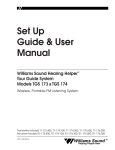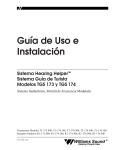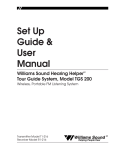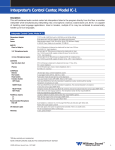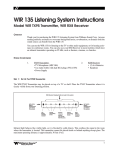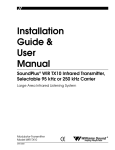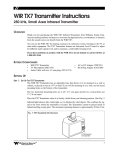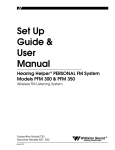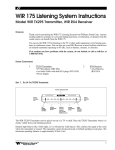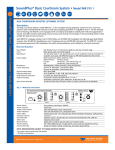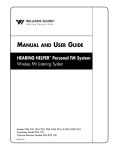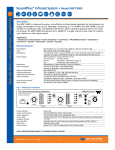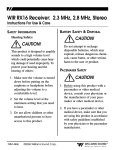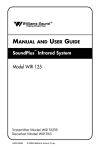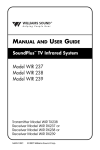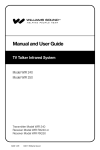Download Williams Sound PFM 174 User guide
Transcript
® Williams Sound Helping People Hear MANUAL AND USER GUIDE HEARING HELPER™ Personal FM System Wireless FM Listening System Models PFM 173 & PFM 174 Transmitter Models T1-173.400, T1-174.100, T1-174.300, T1-175.500, T1-176.300 Receiver Models R1-173.400, R1-174.100, R1-174.300, R1-175.500, R1-176.300 MAN 107C HEARING HELPER® PERSONAL FM SYSTEM, MODELS PFM 173 & PFM 174 INSTALLATION GUIDE & USER MANUAL CONTENTS 2 PAGE System Overview 3 System Components 4 Safety Information 5 Recycling Instructions 5 Using the Transmitter 6 Using the Receiver 7 Battery Information 8 Using Your Personal FM System With A Hearing Aid 10 Applications For Various Hearing Loss Levels 11 In Case Of Difficulty 12 Warranty 13 Acoustic Specifications 14 System Specifications 15 Williams Sound ® Helping People Hear SYSTEM OVERVIEW Thank you for purchasing the Hearing Helper™ Personal FM System from Williams Sound Corp. Anyone needing auditory assistance to overcome background noise, reverberation, or distance from the sound source can benefit from the Personal FM System. Your PFM System has two principal parts: the Transmitter and the Receiver. Much like a miniature radio station, the Transmitter and microphone pick up the sounds you want to hear and broadcast them over an FM radio signal. The receiver and earphone are used to pick up the broadcast up to 100 feet away. To avoid difficulties, please read through these instructions as you begin to use the system. Then save them for questions that arise as you continue to use your Williams Sound Personal FM System. FIGURE 1: HOW THE PFM SYSTEM WORKS FM Radio Signal Speaker Uses Transmitter With Microphone Listeners use Receivers with Earphones, Headphones, Or Neckloop The speaker wears the body-pack transmitter and a clip-on microphone. The speaker’s voice is broadcast as an FM radio signal over a distance of 100-150 feet (30-45 m). Listeners use the pocket receiver and earphone or headphone to hear the speaker’s voice directly, with reduced background noise. A neckloop telecoil coupler allows the system to be used with telecoil (T-Switch) equipped hearing aids. Williams Sound ® Helping People Hear 3 SYSTEM COMPONENTS þ Body Pack Transmitter with (2) AA batteries (BAT 001) þ Lavalier microphone (MIC 090) þ Mini earphone (EAR 013) þ Soft Nylon System Carry Case (CCS 020) þ (2) Belt clip cases (CCS 001) þ Instructions (MAN 107) þ Personal FM Receiver with (2) AA batteries (BAT 001) FIGURE 2: SYSTEM COMPONENTS Microphone Earphone On/Off & FM Volume On/Off Switch Mic Jack Williams Sound Williams Sound Hearing Helper Williams Sound Williams Sound ® Hearing Helper ® Transmitter 4 Hearing Helper ® Hearing Helper ® Receiver Williams Sound ® Helping People Hear SAFETY INFORMATION HEARING SAFETY CAUTION! This product is designed to amplify sounds to a high volume level which could potentially cause hearing damage if used improperly. To protect your hearing and the hearing of others: 1. Make sure the volume is turned down before putting on the earphone or headphone before adjusting the volume to a comfortable level. 2. Set the volume level at the minimum setting that you need to hear. 3. If you experience feedback (a squealing or howling sound), reduce the volume setting and move the microphone away from the earphone or headphone. 4. Do not allow children or other unauthorized persons to have access to this product. BATTERY SAFETY AND DISPOSAL CAUTION! This product is supplied with disposable Alkaline batteries. Do not attempt to recharge disposable batteries, which may explode, release dangerous chemicals, cause burns, or other serious harm to the user or product. PACEMAKER SAFETY: CAUTION! 1. Before using this product with a pacemaker or other medical device, consult your physician or the manufacturer of your pacemaker or other medical device. 2. If you have a pacemaker or other medical device, make sure that you are using this product in accordance with safety guidelines established by your physician or the pacemaker manufacturer. RECYCLING INSTRUCTIONS BATTERY SAFETY AND DISPOSAL Help Williams Sound protect the environment! Please take the time to dispose of your equipment properly. Product Recycling for Customers in the European Union: Please do NOT dispose of your Williams Sound equipment in the household trash. Please take the equipment to a electronics recycling center; OR return the product to the factory for proper disposal. Battery Recycling for Customers in the European Union: Please do NOT dispose of used batteries in the household trash. Please take the batteries to a retail or community collection point for recycling. 08/18/05 Williams Sound ® Helping People Hear 5 USING THE TRANSMITTER Note: Rechargeable batteries are shipped in a discharged state and must be charged overnight before using. 1. Make sure there are two charged AA batteries in the transmitter. If batteries are not installed, see Battery Information on page 8. FIG. 3: TRANSMITTER TOP VIEW Off Mic Mic Jack On FM On/Off Switch ON Indicator Williams Sound FM 2. Plug the microphone cord into the “Mic” jack on top of the Transmitter. 3. Place the Transmitter in the belt clip case provided. 4. Turn the power switch on top of the Transmitter to “On.” 5. Clip the microphone onto a collar, lapel, or tie. It should be as close to the speaker’s mouth as is practical. (See Figure 4.) The transmitter can be placed in a pants pocket, or clipped onto a belt or waistband. Make sure the Transmitter is turned OFF when not in use. FIGURE 4: CORRECT MICROPHONE PLACEMENT Yes Yes No No The PFM System comes with an omnidirectional, lapel-clip style microphone. It should be clipped to a collar, lapel, tie, or neckline as close to the mouth as possible and centered on the body as shown. Note On The Transmitter Antenna: The microphone cord is the transmitting antenna. Do not bunch up the cord or wrap it around the transmitter. For maximum range, the cord should hang as straight as possible. 6 Williams Sound ® Helping People Hear USING THE RECEIVER: Note: Rechargeable batteries are shipped in a discharged state and must be charged overnight before using. 1. Make sure there are two charged AA batteries in the Receiver. If batteries are not installed, see Battery Information on page 8. 2. Plug the earphone or headphone into the “Ear” jack on top of the Receiver. FIGURE 5: RECEIVER TOP VIEW "On" Indicator LED EAR Volume Headphone Jack 1 On/Off Volume Switch 3. Turn the power on by rotating the volume control on top of the Receiver. 4. Place the earphone in your ear. 6. Adjust the receiver volume control to a comfortable listening level. You should be able to hear someone speaking into the Transmitter microphone. 8. Place the Receiver in the belt clip case provided. The Receiver can be placed in a pants pocket, or clipped onto a belt, harness, or waistband. Notes: The earphone cord is the receiving antenna. Do not bunch up the cord or wrap it around the receiver. For best reception, the cord should hang as straight as possible. Make sure the Receiver is turned OFF when not in use. Williams Sound ® Helping People Hear 7 BATTERY INFORMATION INSTALLATION Open the battery compartment using a coin in the slot in the bottom of the receiver or transmitter. Press the batteries into place, observing proper battery polarity. Incorrect insertion of the battery is difficult, and if forced, may cause both mechanical and electrical damage to transmitters or receivers not covered by the five year warranty. Units will not work with the battery incorrectly installed. FIGURE 6: INSTALLATION OF BATTERIES Rear of Transmitter or Receiver Battery Compartment Note Proper Polarity – + + – Pry Slot NON-RECHARGEABLE BATTERIES In normal use, two AA 1.5 V alkaline batteries (BAT 001) will last about 12 hours in the Transmitter and approximately 30 hours in the Receiver. If the sound becomes weak or distorted, replace the batteries. Do not leave dead batteries in the receivers. Battery corrosion is not covered by the Williams Sound five year warranty. RECHARGEABLE BATTERIES The Transmitter and Receivers can use rechargeable AA batteries (BAT 026). On an overnight charge, these NiMH batteries are designed to operate a Transmitter for approximately 8 hours, and Receivers for 20 hours. The battery installed in the receiver may be recharged in the receiver only if it is a Nickel-Metal Hydride (NiMH) battery, and only if a Williams Sound CHG 1600-02 Multi-Charger is used. Damage from improper charging is not covered by the Williams Sound five year warranty. For charging instructions, see figure 7. Important Rechargeable Battery Information Rechargeable batteries are shipped in a discharged condition. They must be charged for a complete charge cycle before the first use (approximately 15 hours). Rechargeable batteries will need to be replaced after 1-2 years of use. Do not dispose of batteries in fire. Do not open batteries, there are toxic chemicals inside. 8 Williams Sound ® Helping People Hear FIGURE 7: USING THE OPTIONAL CHG 200-02 BATTERY CHARGER TO CHARGE TRANSMITTERS AND RECEIVERS Step 1: Plug the CHG 200-02’s power supply into the Power Input on the charger’s side and a standard AC wall outlet. Step 2: Route the power cord around the Cord Hook (see figure at right). This will minimize strain on the cord and jack and insure that the power cord is not detached during charging. Step 3: Make sure the receivers/transmitters to be charged are turned OFF. Step 4: Place the receivers/transmitters in the slots so that the CHG 200-02’s Charging Pins and receiver’s side panel contacts are coupled. Make sure that the charging contact holes line up with the charging pins. The receivers should drop easily into the slots. DO NOT FORCE THEM IN BACKWARDS. Step 5: Charging Contact Holes Charging Indicators Charging Pins The Charging Indicators will light, indicating that charging is in process. It takes 14–16 hours to fully charge the batteries. Remove the receivers when charging is completed. Cord Hook Power Input FURTHER SUGGESTIONS Receivers and Transmitters SHOULD NOT be left charging continuously when not in use. Receivers should always be turned OFF while charging. It’s best to allow the batteries to fully discharge before charging. If the batteries are near end of life and the LED turns off while the receiver is operating, this is an indication to change or recharge your batteries. Approximately one hour of battery life remains. Repeatedly charging the batteries after short periods of use (1-2 hours) will shorten battery life. Rechargeable batteries will need to be replaced after 1–2 years of use. !! WARNING !! DO NOT ATTEMPT TO RECHARGE DISPOSABLE BATTERIES! The batteries may heat up and burst, causing possible injury and damage to the equipment. Avoid shorting the plus and minus battery terminals together with metal objects. Battery damage and burns can result! Use only Williams Sound supplied chargers and batteries. Williams Sound ® Helping People Hear 9 USING YOUR PERSONAL FM SYSTEM WITH A HEARING AID If you have a hearing aid equipped with a Telecoil (T-Switch), you can use a Neckloop (NKL 003–children’s size, or NKL 001–adult’s size) to magnetically couple the signal from the PFM Receiver into your hearing aid. The Neckloop plugs into the earphone jack of the receiver. Turn the switch to the “T” position on your hearing aid and adjust the volume control on the receiver to a comfortable level. Direct Audio Input cords can be used with compatible hearing aids as well as with Cochlear Implant Processors. If your hearing aid has a direct audio input boot, you can obtain a cord from your hearing aid manufacturer to plug directly into the PFM receiver. The cord should have a 3.5 mm plug. 10 Williams Sound ® Helping People Hear APPLICATIONS FOR VARIOUS HEARING LOSS LEVELS The Personal FM is designed to provide hearing assistance for anyone when background noise or distance from the sound source make listening difficult. The microphone and transmitter are placed close to the desired sound source to help minimize background noise and to effectively eliminate the distance between the listener and the sound source. Because hearing ability varies, three categories of amplification have been delineated: NO HEARING LOSS – LOW AMPLIFICATION Among Low Amplification applications are classroom and similar uses. The PFM System can be used with headphones or earphones for Central Auditory Processing Disorders, Learning Disabilities, or Attention Deficit Disorders. The PFM System is used primarily to boost speech sounds above other background noises, making it easier for the listener to focus on what is being said. The optional Rugged Headphone (HED 022–children’s size, and HED 021–adult’s size) or HED 026 Rear-Wear Headphone are recommended for this application. The EAR 013 Single Mini Earphone, EAR 008 Surround Earphone, or EAR 014 Dual Mini Earphone can also be used. MILD – MODERATE HEARING LOSS These applications include the classroom, TV listening, car riding, and one-on-one conversations. The PFM System can be used with the Single or Dual Mini Earphone (EAR 013 or EAR 014) for moderate amplification fittings. The Button Receiver Earphone (EAR 012 WC) is also available for use with a snap-on custom earmold. The PFM System is also suitable for temporary mild hearing loss due to Otitis Media. The Rugged Headphones (HED 021) or Surround Earphone (EAR 022 or EAR 008) are recommended since they do not enter the ear canal. SEVERE – PROFOUND HEARING LOSS These applications include the classroom, TV listening, car riding, and one-on-one conversations. For severe to profound hearing loss, the PERSONAL FM System should be used in conjunction with a hearing aid. A Neckloop can be used with hearing aids that have a telecoil. An adaptor cord can be used with hearing aids that have direct audio input. Williams Sound ® Helping People Hear 11 IN CASE OF DIFFICULTY If your Personal FM System is not working, check the following: 1. Read though the manual and user guide carefully to verify proper setup and installation of your system. 2. Make sure the batteries are fresh or completely charged and that the “plus” and “minus” terminals are installed correctly. 3. If the rechargeable batteries will only work for a short period of time (less than 1 hour) even after they are fully charged, they must be regenerated. Leave them in the receiver or transmitter with the unit turned on, for 5 - 6 hours. Then turn receiver or transmitter off, place it in the charger, and charge for 14 - 16 hours. This should restore normal battery life. Rechargeable batteries will gradually lose their capacity over time and should be replaced every year. 4. Make sure the microphone is plugged into the Transmitter and the earphone is plugged into the Receiver. 5. Move the Transmitter and Receiver closer together. You may be out of range. When using the system indoors, it’s normal for the signal to momentarily disappear in certain locations. This is called a “drop-out.” Moving a few feet will restore the signal. 6. Make sure that the Transmitter and Receivers are tuned to the same channel. The units have stickers inside the back cover identifying the channel. Unless the Transmitter channel has been changed, set the Receiver to channel 1. 7. Do not try to use more than one Transmitter on the same channel in close proximity to each other. MORE THAN ONE TRANSMITTER ON THE SAME CHANNEL WILL RESULT IN INTERFERENCE IF THEY ARE CLOSE TOGETHER. Keep the systems 50 – 100 feet apart or use separate channels for each system used. 8. If you are still hearing interference on the Receivers, turn the Transmitter off and listen with a receiver. If you hear the interference with the Transmitter off, you need to change to a clear channel. Contact Williams Sound at [email protected] for assistance. 9. If problems remain, contact your dealer for further help. Or contact Williams Sound at [email protected]. 12 Williams Sound ® Helping People Hear LIMITED WARRANTY Williams Sound products are engineered, designed, and manufactured under carefully controlled conditions to provide you with many years of reliable service. Williams Sound warrants the Hearing Helper™ Personal FM System against defects in materials and workmanship for FIVE (5) years. During the first five years from the purchase date, we will promptly repair or replace the Hearing Helper™ Personal FM System. Microphones, earphones, headphones, batteries, chargers, cables, carry cases, and all other accessory products carry a 90-day warranty. WILLIAMS SOUND HAS NO CONTROL OVER THE CONDITIONS UNDER WHICH THIS PRODUCT IS USED. WILLIAMS SOUND, THEREFORE, DISCLAIMS ALL WARRANTIES NOT SET FORTH ABOVE, BOTH EXPRESS AND IMPLIED, WITH RESPECT TO THE HEARING HELPER™ PERSONAL FM SYSTEM, INCLUDING BUT NOT LIMITED TO, ANY IMPLIED WARRANTY OF MERCHANTABILITY OR FITNESS FOR A PARTICULAR PURPOSE. WILLIAMS SOUND SHALL NOT BE LIABLE TO ANY PERSON OR ENTITY FOR ANY MEDICAL EXPENSES OR ANY DIRECT, INCIDENTAL OR CONSEQUENTIAL DAMAGES CAUSED BY ANY USE, DEFECT, FAILURE OR MALFUNCTIONING OF THE PRODUCT, WHETHER A CLAIM FOR SUCH DAMAGES IS BASED UPON WARRANTY, CONTRACT, TORT OR OTHERWISE, THE SOLE REMEDY FOR ANY DEFECT, FAILURE OR MALFUNCTION OF THE PRODUCTS REPLACEMENT OF THE PRODUCT. NO PERSON HAS ANY AUTHORITY TO BIND WILLIAMS SOUND TO ANY REPRESENTATION OR WARRANTY WITH RESPECT TO THE HEARING HELPER™ PERSONAL FM SYSTEM. UNAUTHORIZED REPAIRS OR MODIFICATIONS WILL VOID THE WARRANTY. The exclusions and limitations set out above are not intended to, and should not be construed so as to contravene mandatory provisions of applicable law. If any part or term of this Disclaimer of Warranty is held to be illegal, unenforceable, or in conflict with applicable law by a court of competent jurisdiction, the validity of the remaining portions of this Disclaimer of Warranty shall not be affected, and all rights and obligations shall be construed and enforced as if this Limited Warranty did not contain the particular part or term held to be invalid. If you experience difficulty with your system, contact your local Distributor or our European Sales Office. If it is necessary to return the system for service, a Williams Sound representative will give you a Return Authorization Number (RA) and shipping instructions. Pack the system carefully and send it to: U.S. Office European Sales Office Williams Sound Corp. 10321 West 70th Street Eden Prairie, MN 55344 USA e-mail: Phone: 952-943-2252 Fax: 952-943-2174 TTY: 952-943-9675 e-mail: [email protected] [email protected] [email protected] Your warranty becomes effective the date you purchase your system. Your returned warranty card is our way of knowing when your warranty begins. It also gives us important information about your system including the serial number. This information will help us serve you better in the future. Please take a moment to complete and mail the attached card. Thank you. Williams Sound ® Helping People Hear 13 ACOUSTIC SPECIFICATIONS ANSI S3.22–1987 TEST FM Response (Transmitter, Receiver) Max. SSPL90: 118.2 dB at 700 Hz HF Avg SSPL90: 113.7 dB HF Avg Full On Gain: 27.5 dB at 60 dB in Reference Test Gain: 27.5 dB Response Limit: 67.4 dB, F1=200 Hz, F2=8 kHz Total Harmonic Distortion: 1.3% at 500 Hz 0.5% at 800 Hz 0.7% at 1600 Hz EQ Input Noise: 38.6 dB Reference Test Gain: 27.5 dB MAXIMUM VOLUME, 2CC COUPLER, EAR 013 dB SPL 60 dB RESP. 90 110 80 100 70 90 60 80 250 500 1000 2000 4000 Frequency (Hz) 60 dB Resp Curve 14 SSPL90 Curve Williams Sound ® Helping People Hear TECHNICAL SPECIFICATIONS FM Transmitter Models: Dimensions: Weight: Color: Battery Type: Operating Frequencies: Stability: Modulation: RF Output: Freq Response: Signal–Noise Ratio: Compressor: Transmit Antenna: Microphone: Controls & Indicators: Mic Connector: Charging Contacts: Approvals: T1-173.400, T1-174.100, T1-174.300, T1-175.500, T1-176.300 3-5/8" L x 2-3/8" W x 7/8" H (92.1 mm x 60.3 mm x 22.2 mm) 4.4 oz (125 g) with batteries Neptune blue, shatter-resistant polypropylene Two (2) AA 1.5 V Non-rechargeable Alkaline batteries (BAT 001), 100 mA nominal current drain, 12 hours approx. life (OR) Two (2) AA 1.5 V NiMH Rechargeable batteries (BAT 026), 8 hours per charge approx., recharges in 14–16 hours, uses CHG 1600 Multiple Battery Charger Fixed 173.400 (UK only), 174.100, 174.300, 175.500, 176.300 MHz ± .005%, crystal reference Narrow-band FM, 10 kHz, 100 µS pre-emphasis 1.5 mW typical 100 Hz to 10 kHz, ± 3 dB at 1% max. THD 55 - 60 dB, with R1-173 Receiver Compressor uses adjustable slope and noise gate Integral with 39" microphone cord Lavalier microphone, omni condenser, 39 in. cord, 3.5 mm mono phone plug (MIC 090) On/Off switch, slide-type; “On” Indicator LED 3.5 mm mono phone jack Designed for use with CHG 1600 and CHG 200 Multiple Battery Chargers MPT 1345, ETS 300 422, CE FM Receiver Models: Dimensions: Weight: Color: Battery Type: Operating Frequencies: Stability: FM Deviation: AFC Range: Sensitivity: Freq Response: Signal–Noise Ratio: Receive Antenna: Audio Output: Output Connector: Squelch: Controls: Indicators: Approvals: Note: Williams Sound ® Helping People Hear R1-173.400, R1-174.100, R1-174.300, R1-175.500, R1-176.300 3-5/8" L x 2-3/8" W x 7/8" H (92.1 mm x 60.3 mm x 22.2 mm) 4.6 oz (130 g) with batteries Neptune blue, shatter-resistant polypropylene Two (2) AA 1.5 V non-rechargeable Alkaline batteries (BAT 001), 42 mA nom. current drain, 30 hours approx. life (OR) Two (2) AA 1.5 V NiMH rechargeable batteries (BAT 026), 20 hours per charge approx., recharges in 14–16 hours, uses CHG 1600 Multiple Battery Charger Fixed 173.400 (UK only), 174.100, 174.300, 175.500, 176.300 MHz ± .005%, crystal reference Narrow-band FM, 10 kHz, 100 µS de-emphasis ± 120 kHz .5 µV at 12 dB Sinad with squelch defeated, squelches at 8 µV for min. 50 dB S/N ratio 200 Hz to 10 kHz, +2, –4 dB 60 dB at 10 µV Integral with earphone cord 35 mW, max. at 16 Ω; for use with 8–32 Ω mono headphones 3.5 mm mono phone jack Set to turn off audio under weak or no signal condition Volume: thumbwheel/on/off/volume “On” LED MPT 1345, ETS 300 422, CE Specifications are electrical performance 15 16 Williams Sound ® Helping People Hear ® Williams Sound Helping People Hear www.williamssound.com © 2005, Williams Sound Corp. MAN 107C (ENG)




















